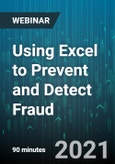Overview
This webinar training pays for itself in terms of your firm's potential savings and detection of fraud.
The training is designed to both prevent and detect fraud. We first teach you how to establish an administrative environment where fraud is less likely to occur.
We'll then examine Excel tools that are used by CPAs and Internal Auditors to detect fraud.
Properly informed, administrative and financial professionals can serve as fraud auditors and add huge value to their department. Using Excel's fraud related applications, you can data mine huge volumes of accounting transactions in an organized manner and recover substantial amounts of money for your firm.
Excel provides several easy-to-use tools that can greatly enhance and expedite the fraud audit process. This course will demonstrate how to use a variety of Excel tools along with step-by-step instructions that you can put to immediate use to help your firm spot fraud red flags.
This interesting, informative, practical, on-the-job training combines the best aspects of two different but related topics: (1) Fraud Auditing and (2) Excel Tools for Data Mining, Statistics, Analytics, and many more useful Excel tools.
Why you should Attend
Course outline
Areas Covered in the Session
This webinar training pays for itself in terms of your firm's potential savings and detection of fraud.
The training is designed to both prevent and detect fraud. We first teach you how to establish an administrative environment where fraud is less likely to occur.
We'll then examine Excel tools that are used by CPAs and Internal Auditors to detect fraud.
Properly informed, administrative and financial professionals can serve as fraud auditors and add huge value to their department. Using Excel's fraud related applications, you can data mine huge volumes of accounting transactions in an organized manner and recover substantial amounts of money for your firm.
Excel provides several easy-to-use tools that can greatly enhance and expedite the fraud audit process. This course will demonstrate how to use a variety of Excel tools along with step-by-step instructions that you can put to immediate use to help your firm spot fraud red flags.
This interesting, informative, practical, on-the-job training combines the best aspects of two different but related topics: (1) Fraud Auditing and (2) Excel Tools for Data Mining, Statistics, Analytics, and many more useful Excel tools.
Why you should Attend
Course outline
- Overview of fraud
- Scope size of fraud annually
- Internal control and segregated functions
- Understanding and using the fraud triangle
- Troubleshooting potential fraud red flags with Excel designed analytics
- Horizontal and vertical analysis
- Metrics: ratio analysis and disaggregated information
- Trend analysis - charting linear regression analysis for speed
- Sample dashboard analytics and fraud red flags
- Understanding and using Benford's law with Excel to spot potential fraud
- Establishing a template for Expectations vs. Actual results
- First and second digit test and needed Excel functions
- Limitations of Benford's law
- Using gaps in numbers to spot fraud red flags with Excel
- Using Excel's special tools and functions to spot fraud red flags
- Excel tools for spotting duplicate payments: payroll, vendor invoices, more
- Stratifications, frequencies and maximum analysis
- Receivables and inventory
- Payables, payroll and disbursements
- Finding fictitious vendors, payroll comparisons, duplicate payments, more
- Fictitious sales - bonuses to salesmen - using pivot tables to age receivables
- Fraudulent travel and expense account items
- Auto fleet: fraudulent gas purchases
Areas Covered in the Session
- Establish a system of internal control that makes fraud difficult
- Use automated analytics to spot potential fraud
- Learn the high risk areas for fraud - spot fraud red flags
- Master several Excel functions and analysis tools used to detect fraud
- Understand Benford’s law and apply it to Excel
- Recover misused assets and add value to your organization
Speaker
Joseph Weil has a Master of Accounting Degree from Florida State University and is an actively licensed Florida CPA. Joe’s work experience includes staff accountant with large CPA firm, corporate controller, state agency director of auditing and former municipal CFO. Joe also started and sold his own CPA firm. Joe is the owner and CEO of the National Center for Continuing Education, a nation-wide financial and technology training firm. Joe has led over 500 seminars and over 100 webinars.Past in-house seminar/webinar clients have included Harley-Davidson, Hewlett-Packard, General Mills, Oracle, Burger King, Deloitte, Florida Power and Light and many similar organizations.
Who Should Attend
- Accountants (staff through manager)
- Financial Analysts
- Budget Managers/Directors
- Data Analysts
- IT Analysts
- CFOs
- Controllers
- Internal Auditors
- Anyone who wants to move from being a basic Excel user to becoming an intermediate-level Excel user.








